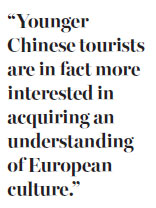No one-size-fits-all for Chinese tourists
Updated: 2016-03-04 07:59
By Mike Bastin(China Daily Europe)
|
|||||||||

European operators should realize that different age groups now have different approaches to holidays
And so the Chinese New Year holiday has ended for another year and we can now settle down to the Year of the Monkey. Or can we?
Certainly not if you are part of the European tourist industry, for there are many lessons that need to be learned.
Once again, record numbers of Chinese traveled overseas during the Golden Week holiday and not just to neighbouring Asian economies: Increasing numbers ventured to European shores.
An estimated 6 million Chinese traveled abroad during this year's festivities, but my research continues to show that overseas tourism players have made little progress in understanding this growing and increasingly diverse group of customers.
This is not to say that absolutely no progress has been made. In recent years the European tourism industry has catered more and more to Chinese tourists by recruiting more Chinese employees as major part of a their strategy.
But the European tourism industry still appears to perceive Chinese tourists as a homogenous market segment. It is difficult to fathom precisely why this remains the case despite numbers now reaching just over 6 million. It may be the result of some similar but relatively trivial needs across this large and growing group, such as the desire for hot rather than cold water.

Even a cursory demographic profiling of these overseas-bound Chinese New Year tourists reveals a widening range of ages. Increasing numbers of late teens, and early 20-somethings now travel independently to Europe and regard Chinese New Year as one of the few opportunities for a lengthy European holiday experience. At the same time, older, often retired, Chinese tourists form a sizeable part of this tourism tidal wave.
Surely, European tourism operators make some effort at segmenting their customer base by age for European and Western tourists? Of course they do. But it would appear they do not for Chinese tourists.
This oversight turns out to be all the more incredible given the very different needs and wants across the Chinese New Year tourist super-segment.
While European tour operators appear to be trying to tailor their packages to what they perceive to be the typical Chinese tourists, with efforts made to recruit Chinese- speaking employees and staff training programs designed to inform customer-contact staff members about the importance and meaning of Chinese New Year and other significant aspects of Chinese culture, they need to understand that younger Chinese tourists are in fact more interested in acquiring an understanding of European culture.
Furthermore, younger Chinese tourists decide to travel overseas, particularly at Chinese New Year, to "escape" temporarily from their Chinese lifestyles and seek to become ensconced in aspects of European culture. Language is also not that much of a barrier for this intrepid, youthful cohort.
Increasingly independent and self-confident, younger Chinese tourists are also eschewing the multitude of package-holiday deals with rigid itineraries and little opportunity for genuine adventure.
This segment of the overseas Chinese tourist segment, most of whom were born after 1980, are also keen to distinguish themselves, their lifestyles and values from older, more traditional, Chinese tourists.
Paradoxically, therefore, European tour operators need to move quickly and decisively into reverse gear and remove any Chinese-style adaptation to their offering and somehow provide increased opportunities for this group to gain an in-depth understanding of the local cultures.
At the other end of the demographic scale, older and probably more traditional and conservative Chinese tourists are perhaps more easily understood. However, even their needs and wants appear to be understood at a superficial level. European hotels that supply hot instead of cold water and paper slippers have hardly begun to delve deep into the mindset of this, often affluent, segment.
Surveying a small but statistically significant batch of European tourism industry players recently, I was amazed to find that over half were not aware that this year was the Year of the Monkey. And even those who did reply correctly could not even begin to discuss any meaning attached to the Year of the Monkey.
Such an understanding would definitely be received warmly by older Chinese tourists.

Some knowledge of the meaning of the 15 days that start each Chinese New Year and culminate in the Lantern Festival would also be met positively by this age group.
Organized package-holiday deals still appeal to older Chinese tourists, but even here my research reveals change taking place. Even these more conservative tourists are now keen to integrate a little more into their surroundings and almost resent being treated separately from other international tourists. While language remains a barrier, this does not mean that Chinese tourists should be isolated.
Older generations also see a Chinese New Year overseas holiday as one of the few opportunities to learn about different cultures, and they value ancient culture and history more than their younger compatriots.
The European tourism industry should also understand that the process of change across this segment is ongoing and difficult to predict.
It therefore needs the European tourism industry to invest considerably in market research. Simple tick-box questionnaires are not totally useless, but they come pretty close. To gain real insight into the feelings and desires of Chinese tourists it is necessary to employ more modern, qualitative research methods. Observation or even some form of "mystery shopper" approach are probably most suitable, where holiday experiences can be "recorded" without the Chinese tourist being made aware that their activities and behavior are being monitored. In addition, in-depth interviews and focus groups should also be employed to dig deep into the mindset of this group of consumers.
European tour operators should be prepared for demographics to play an important role, but also psychographics. Psychographic segmentation variables such as personality and values will probably usurp simple demographic profiling, and provide a more informed understanding of different types of Chinese tourists, and soon.
Effective market segmentation is widely considered the sine qua non in any brand-building process. In so doing, segmentation should lead to real understanding of different groups of consumers.
The author is a visiting professor at the University of International Business and Economics in Beijing and a senior lecturer at Southampton University. The views do not necessarily reflect those of China Daily.
Today's Top News
Inspectors to cover all of military
Britons embrace 'Super Thursday' elections
Campaign spreads Chinese cooking in the UK
Trump to aim all guns at Hillary Clinton
Labour set to take London after bitter campaign
Labour candidate favourite for London mayor
Fossil footprints bring dinosaurs to life
Buffett optimistic on China's economic transition
Hot Topics
Lunar probe , China growth forecasts, Emission rules get tougher, China seen through 'colored lens', International board,
Editor's Picks

|

|

|

|

|

|







